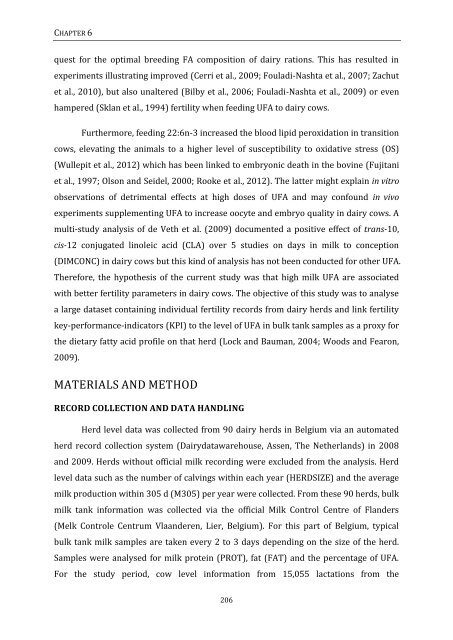view - Department of Reproduction, Obstetrics and Herd Health
view - Department of Reproduction, Obstetrics and Herd Health
view - Department of Reproduction, Obstetrics and Herd Health
Create successful ePaper yourself
Turn your PDF publications into a flip-book with our unique Google optimized e-Paper software.
CHAPTER 6<br />
quest for the optimal breeding FA composition <strong>of</strong> dairy rations. This has resulted in<br />
experiments illustrating improved (Cerri et al., 2009; Fouladi-Nashta et al., 2007; Zachut<br />
et al., 2010), but also unaltered (Bilby et al., 2006; Fouladi-Nashta et al., 2009) or even<br />
hampered (Sklan et al., 1994) fertility when feeding UFA to dairy cows.<br />
Furthermore, feeding 22:6n-3 increased the blood lipid peroxidation in transition<br />
cows, elevating the animals to a higher level <strong>of</strong> susceptibility to oxidative stress (OS)<br />
(Wullepit et al., 2012) which has been linked to embryonic death in the bovine (Fujitani<br />
et al., 1997; Olson <strong>and</strong> Seidel, 2000; Rooke et al., 2012). The latter might explain in vitro<br />
observations <strong>of</strong> detrimental effects at high doses <strong>of</strong> UFA <strong>and</strong> may confound in vivo<br />
experiments supplementing UFA to increase oocyte <strong>and</strong> embryo quality in dairy cows. A<br />
multi-study analysis <strong>of</strong> de Veth et al. (2009) documented a positive effect <strong>of</strong> trans-10,<br />
cis-12 conjugated linoleic acid (CLA) over 5 studies on days in milk to conception<br />
(DIMCONC) in dairy cows but this kind <strong>of</strong> analysis has not been conducted for other UFA.<br />
Therefore, the hypothesis <strong>of</strong> the current study was that high milk UFA are associated<br />
with better fertility parameters in dairy cows. The objective <strong>of</strong> this study was to analyse<br />
a large dataset containing individual fertility records from dairy herds <strong>and</strong> link fertility<br />
key-performance-indicators (KPI) to the level <strong>of</strong> UFA in bulk tank samples as a proxy for<br />
the dietary fatty acid pr<strong>of</strong>ile on that herd (Lock <strong>and</strong> Bauman, 2004; Woods <strong>and</strong> Fearon,<br />
2009).<br />
MATERIALS AND METHOD<br />
RECORD COLLECTION AND DATA HANDLING<br />
<strong>Herd</strong> level data was collected from 90 dairy herds in Belgium via an automated<br />
herd record collection system (Dairydatawarehouse, Assen, The Netherl<strong>and</strong>s) in 2008<br />
<strong>and</strong> 2009. <strong>Herd</strong>s without <strong>of</strong>ficial milk recording were excluded from the analysis. <strong>Herd</strong><br />
level data such as the number <strong>of</strong> calvings within each year (HERDSIZE) <strong>and</strong> the average<br />
milk production within 305 d (M305) per year were collected. From these 90 herds, bulk<br />
milk tank information was collected via the <strong>of</strong>ficial Milk Control Centre <strong>of</strong> Fl<strong>and</strong>ers<br />
(Melk Controle Centrum Vla<strong>and</strong>eren, Lier, Belgium). For this part <strong>of</strong> Belgium, typical<br />
bulk tank milk samples are taken every 2 to 3 days depending on the size <strong>of</strong> the herd.<br />
Samples were analysed for milk protein (PROT), fat (FAT) <strong>and</strong> the percentage <strong>of</strong> UFA.<br />
For the study period, cow level information from 15,055 lactations from the<br />
206









